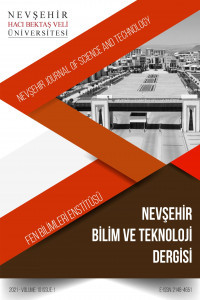Yansıtıcılı reaktörlerin stokastik iki-nokta reaktör kinetik denklemlerinin sayısal simülasyonu
Reflected reactor, Euler-Murayama Method, Stochastic models, Feedback effect
Numerical simulation of stochastic two-point reactor kinetics equations for reflected reactors
Reflected reactor, Euler-Murayama Method, Stochastic models,
___
- [1]. Henry, A. F. 1975. Nuclear Reactor Analysis. MIT Press, Cambridge, MA.
- [2]. Duderstadt, J. J. 1976. Nuclear reactor analysis. Wiley.
- [3]. Hayes, J. G., & Allen, E. J. 2005. Stochastic point-kinetics equations in nuclear reactor dynamics. Annals of nuclear energy, 32(6), 572-587.
- [4]. Da Silva, M. W., Vasques, R., Bodmann, B. E., & Vilhena, M. T. 2016. A nonstiff solution for the stochastic neutron point kinetics equations. Annals of Nuclear Energy, 97, 47-52.
- [5]. Cohn, C. E. 1962. Reflected-reactor kinetics. Nuclear Science and Engineering, 13(1), 12-17.
- [6]. van Dam, H. 1996. Inhour equation and kinetic distortion in a two-point reactor kinetic model. Annals of Nuclear Energy, 23(14), 1127-1142.
- [7]. Spriggs, G. D., Busch, R. D., & Williams, J. G. 1997. Two-region kinetic model for reflected reactors. Annals of Nuclear Energy, 24(3), 205-250.
- [8]. Aboanber, A. E., & Nahla, A. A. 2018. Mathematical treatment for two-point reactor kinetics model of reflected systems. Progress in Nuclear Energy, 105, 287-293.
- [9]. Aboanber, A. E. 2009. Exact solution for the non-linear two-point kinetic model of reflected reactors. Progress in Nuclear Energy, 51(6-7), 719-726.
- [10]. Aboanber, A. E., & Nahla, A. A. 2002. Solution of the point kinetics equations in the presence of Newtonian temperature feedback by Padé approximations via the analytical inversion method. Journal of Physics A: Mathematical and General, 35(45), 9609.
- [11]. Aboanber, A. E., & El Mhlawy, A. M. 2008. A new version of the reflected core inhour equation and its solution. Nuclear engineering and design, 238(7), 1670-1680.
- [12]. Aboanber, A. E., & El Mhlawy, A. M. 2009. Solution of two-point kinetics equations for reflected reactors using Analytical Inversion Method (AIM). Progress in Nuclear Energy, 51(1), 155-162.
- [13]. Holschuh, T. V., Marcum, W. R., & Palmer, T. S. 2017. One-group analytical solution to two-region reactor kinetic model. Annals of Nuclear Energy, 99, 199-205.
- [14]. Hayes, J. G., & Allen, E. J. 2005. Stochastic point-kinetics equations in nuclear reactor dynamics. Annals of nuclear energy, 32(6), 572-587.
- [15]. Hayes, J. G., 2005. Stochastic point kinetics equations in nuclear reactor dynamics, thesis, Texas Tech University.
- [16]. Ray, S. S. 2012. Numerical simulation of stochastic point kinetic equation in the dynamical system of nuclear reactor. Annals of Nuclear Energy, 49, 154-159.
- [17]. Nahla, A. A., & Edress, A. M. 2016. Efficient stochastic model for the point kinetics equations. Stochastic Analysis and Applications, 34(4), 598-609.
- [18]. Saha Ray, S., & Singh, S. 2019. Numerical solutions of stochastic nonlinear point reactor kinetics equations in presence of Newtonian temperature feedback effects. Journal of Computational and Theoretical Transport, 48(2), 47-57.
- [19]. Nahla, A. A. 2017. Stochastic model for the nonlinear point reactor kinetics equations in the presence Newtonian temperature feedback effects. Journal of Difference Equations and Applications, 23(6), 1003-1016.
- [20]. Cyganowski, S., Kloeden, P., & Ombach, J. 2001. From elementary probability to stochastic differential equations with MAPLE®. Springer Science & Business Media.
- [21]. Buldygin, V. V., & Kozachenko, I. V. (2000). Metric characterization of random variables and random processes (Vol. 188). American Mathematical Soc.
- [22]. Iacus, S. M. (2009). Simulation and inference for stochastic differential equations: with R examples. Springer Science & Business Media.
- ISSN: 2148-466X
- Yayın Aralığı: Yılda 2 Sayı
- Başlangıç: 2012
- Yayıncı: Nevşehir Hacı Bektaş Veli Üniversitesi
Elektrot Tipinin Nokta Direnç Kaynaklı DP600 Çeliğinin Mikroyapı ve Sertliğine Etkileri
Bilge DEMİR, Muhammed ELİTAŞ, Hüseyin KARAKUŞ
Gebelikte Kullanılan Kısa Mesaj Hizmeti Temelli Uygulamalar
Pelin CALPBİNİCİ, Aynur KIZILIRMAK
Kanser Hastalarında Görülen Bulantı ve Kusma Semptomlarının Yönetimi
Gülyeter ERDOĞAN YÜCE, Gamze MUZ
Raman Spektroskopisinin İlkeleri ve Mineral Tanımlamalarında Kullanılması
Musa Avni AKÇE, Yusuf Kagan KADIOĞLU
Hekim Hemşire İşbirliğinin İş Doyumuyla İlişkisi
Hibrid Mısır Çeşitlerinin Koçan Özellikleri ve Tane Kalite Kriterleri
Leyla İDİKUT, Mehmet EKİNCİ, Cafer GENÇOĞLAN
Konut Fiyatı Belirlemede Bulanık Mantık Tabanlı Model Yaklaşımı
Halk Sağlığı Uygulamalarının Enterobius Vermicularis’in Korunma ve Kontrolündeki Önemi
Kamuran ÖZDİL, Nimet KARATAŞ, Handan ZİNCİR
Mustafa GÜLTEKİN, Şahlan ÖZTÜRK
Türkiye’de Çocuk İstismar ve İhmaline İlişkin Hemşirelik Alanındaki Lisansüstü Tezlerin İncelenmesi
